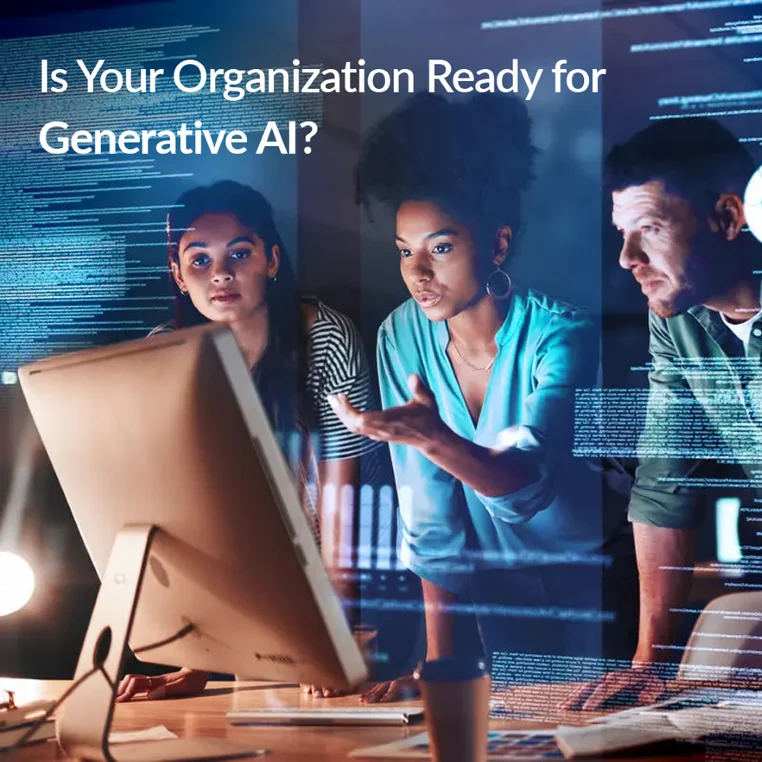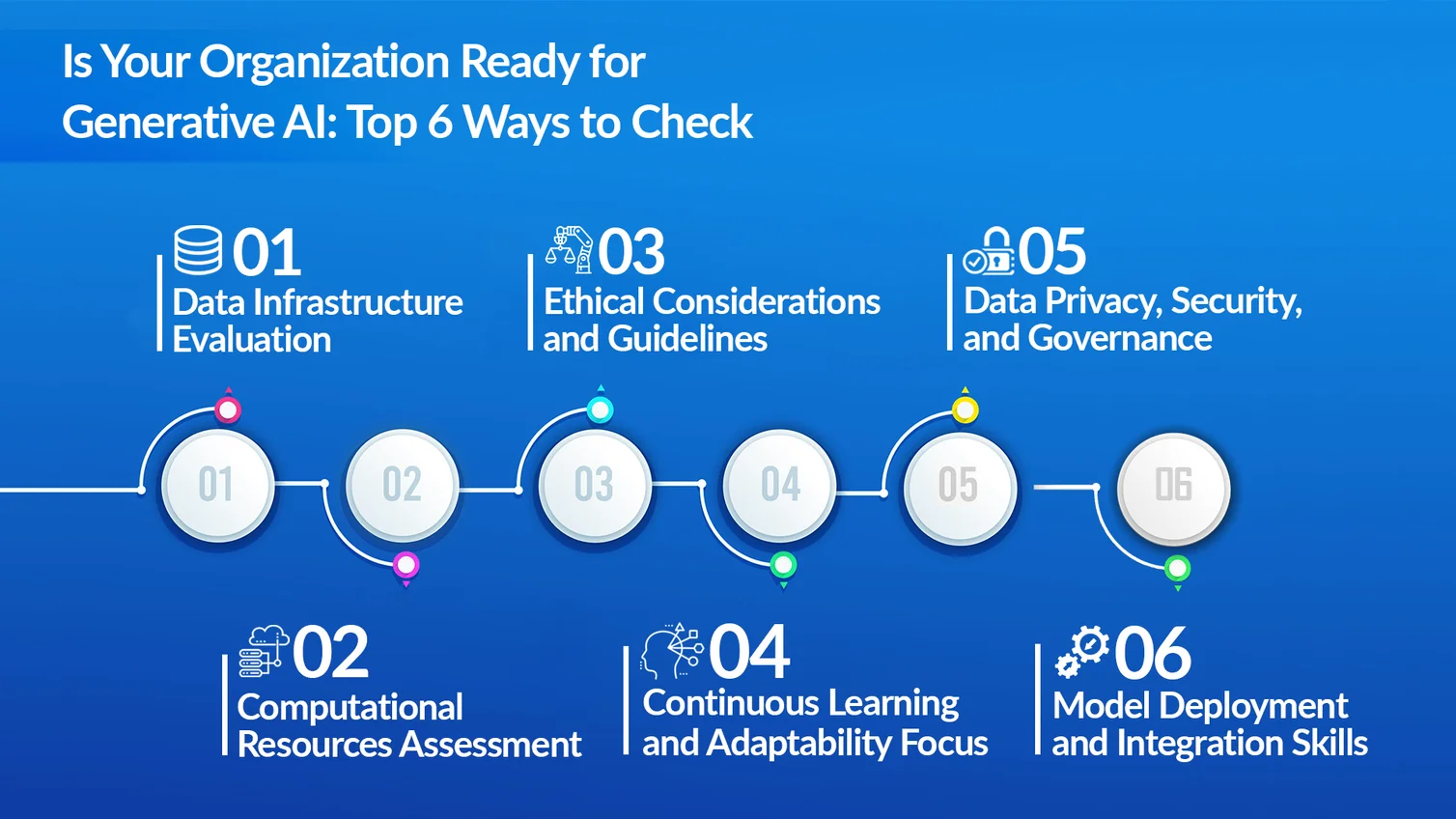Is Your Organization Ready for Generative AI?
This transformative technology will enable organizations to embrace a “copilot” model, where human workers and AI systems collaborate closely. Companies that proactively embrace task-dividing strategies and invest in retraining their workforce to effectively collaborate with machines will establish new performance standards and gain a significant competitive advantage over less forward-thinking competitors.

“Amidst the fervor surrounding the introduction of groundbreaking Generative AI tools like ChatGPT, Bard, Claude, Midjourney, and others, CEOs are rightfully intrigued about the potential impact of this technology. They seek to determine whether they are ready for Generative AI or it is merely a fleeting hype.”- Mckinsey
Is Your Organization Ready for Generative AI: Top 6 Ways to Check
To assess whether your organization is ready for Generative AI, consider the following points:
 1. Data Infrastructure Evaluation
1. Data Infrastructure Evaluation
Conduct a comprehensive evaluation of your organization’s existing data infrastructure to ascertain its aptitude for accommodating the computational exigencies of Generative AI. These models typically impose substantial resource prerequisites, demanding resilient high-performance computing capabilities or cloud-based infrastructure to ensure efficient training and deployment. It is imperative for organizations to meticulously assess the current system’s capacity and ascertain whether it possesses the requisite attributes and scalability to effectively manage the intensive computational workloads associated with Generative AI.
2. Computational Resources Assessment
Assess the computational resources at your organization’s disposal, encompassing both hardware components such as GPUs and TPUs, as well as software frameworks. Given the resource-intensive nature of Generative AI models, it is crucial to ensure that your organization possesses the necessary infrastructure to effectively train and yield results. Generative AI frequently demands substantial computing resources, and thus, it is imperative to evaluate the adequacy of your organization’s computing capabilities. This evaluation should encompass an analysis of both hardware resources, such as specialized graphical processing units (GPUs) or tensor processing units (TPUs), and software frameworks that provide the necessary tools and libraries for efficient Generative AI model development and deployment.
3. Ethical Considerations & Guidelines
Deliberate upon the ethical ramifications of Generative AI, considering its potential to produce realistic yet fabricated content, thereby posing risks such as misinformation dissemination and potential misuse. Your organization must establish unequivocal guidelines and policies that explicitly address these ethical concerns and proactively mitigate any unintended consequences. Such measures are essential to ensure the responsible and ethical use of Generative AI technology. By implementing robust frameworks and comprehensive policies, your organization can effectively safeguard against the misuse and potential harm associated with Generative AI, fostering a culture of integrity, accountability, and responsible AI deployment.
4. Continuous Learning and Adaptability Focus
Assess whether your organization cultivates a culture of continuous learning and adaptability in the realm of Generative AI, considering it’s dynamic and swiftly evolving nature. It is crucial to ascertain if your organization fosters an environment that encourages ongoing training and professional generative ai developments opportunities for the AI team, enabling them to stay abreast of the latest advancements, emerging techniques, and best practices in Generative AI. By prioritizing continuous learning, your organization can effectively equip its AI team with the necessary knowledge and skills to navigate the ever-changing landscape of Generative AI, ensuring they remain at the forefront of technological innovations and maintain a competitive edge in this rapidly evolving field.
5. Data Privacy, Security, and Governance
Deliberate upon the privacy and security implications entailed in employing data for Generative AI purposes. Evaluate your organization’s data governance policies and practices to ensure that the data utilized for training and Generating AI models align with privacy regulations and adhere to industry best practices. It is imperative to implement robust measures to protect sensitive or confidential information from unauthorized access or misuse. Organizations may promote a secure and privacy-conscious workplace, creating trust in stakeholders and reducing risks related to data privacy and security breaches, by undertaking a complete audit of generative ai data governance frameworks and enhancing security processes.
6. Model Deployment and Integration Skills
Assess your organization’s capability to seamlessly deploy and integrate Generative AI models into existing systems or workflows. Evaluate the suitability of your IT infrastructure and development processes to effectively support the deployment and integration of these models. Consider crucial factors such as scalability to handle increased computational demands, the availability of model-serving infrastructure for efficient deployment, and compatibility with existing software and frameworks. A comprehensive generative ai evaluation will enable you to identify any potential gaps or limitations and make informed decisions regarding necessary upgrades or modifications to ensure the successful integration of Generative AI models into your organization’s systems and workflows.
Further Read: An Executive’s Guide to Generative AI Revolution
How can Businesses Prepare Themselves for Generative AI?
The following points can assist businesses in becoming Generative AI-ready:
1. Embrace a new paradigm and unite departments: To stay competitive, organizations should adopt a more collaborative way of thinking and integrating various departments and teams. This involves breaking down silos and fostering collaboration among different areas of the business.
2. Establish a robust governance structure: It is important to create a strong governance framework to address the potential risks and challenges associated with Generative AI. This structure should provide guidelines and protocols for decision-making, accountability, and compliance.
3. Understand data sets, algorithms, and limitations: Companies utilizing Generative AI must develop processes to comprehend the data sets being used, the functionality of algorithms, and the limitations of the technology. Legislative requirements may demand transparency in reporting, so organizations should be prepared to provide insights into their AI processes.
4. Consult with relevant parties: Effective AI initiatives require consultation with various stakeholders, including legal teams, C-suite executives, boards of directors, compliance officers, and HR professionals. It is crucial to involve these parties in decision-making and implementation processes, not solely relying on data scientists.
5. Establish an internal governance framework: Organizations need to develop an internal governance framework that considers risks across all use cases of Generative AI. This framework should enable quick adjustments to ensure compliance and address any issues that may arise during implementation.
6. Assess and mitigate bias: Companies employing Generative AI must create a framework to assess and mitigate bias in their AI systems. This involves actively monitoring and addressing any potential biases that may emerge and taking steps to eliminate them.
7. Comply with data privacy requirements: Organizations need to comply with data privacy regulations when using Generative AI. Companies should establish mechanisms to protect user data and ensure that their AI systems adhere to data protection laws.
8. Establish mechanisms for testing and avoiding unlawful bias: To ensure fairness and avoid unlawful bias, organizations should put in place mechanisms for testing their Generative AI systems. This may involve conducting regular audits, implementing safeguards, and monitoring the outputs of AI models for any discriminatory patterns.
Further read: A Tale of Two Billionaires: Elon Musk and Bill Gates’ Generative AI Views
Conclusion
For businesses aiming to thrive amidst rapid technological advancements, embracing Generative AI is crucial. The transformative potential of Generative AI across various aspects of corporate operations, including product design, consumer engagement, process automation, and data analysis, cannot be overstated. However, organizations must assess their preparedness and establish a strong groundwork before adopting Generative AI technologies. This entails developing a clear strategy, making substantial investments in infrastructure, ensuring data security and quality, and fostering an innovative and collaborative work culture.
Are you looking to leverage the transformative potential of Generative AI for your business? NextGen Invent can help you navigate the exciting world of Generative AI and develop innovative solutions tailored to your organization’s needs.
Contact us today to explore how our expertise in AI and cutting-edge app development can drive your business forward into the future.
Stay In the Know
Get Latest updates and industry insights every month.
 1. Data Infrastructure Evaluation
1. Data Infrastructure Evaluation